Cyamodus
Cyamodus (pron.: SIE-ah-MO-dus) is a genus of placodonts known from several species described from Middle-Late Triassic of Europe and China. The genus was described by Christian Erich Hermann von Meyer in 1863, based on specimens found in Germany. Like some other placodonts, Cyamodus has an armoured carapace composed of irregular hexagonal plates, with the mouth containing a small number of large, rounded teeth that were likely involved in crushing hard shelled organisms (durophagy).
| Cyamodus | |
|---|---|
 | |
| Fossil skeleton | |
| Scientific classification | |
| Domain: | Eukaryota |
| Kingdom: | Animalia |
| Phylum: | Chordata |
| Class: | Reptilia |
| Superorder: | †Sauropterygia |
| Order: | †Placodontia |
| Superfamily: | †Cyamodontoidea |
| Family: | †Cyamodontidae |
| Genus: | †Cyamodus Meyer, 1863 |
| Species | |
| Synonyms | |
| |
Discovery

Thus far, six species of Cyamodus have been identified - C. rostratus, C. munsteri, C. tarnowitzensis, C. hildegardis, C. kuhnschneyderi,[2] and C. orientalis.
Initially considered to be an ancestral turtle due to its testudine-like head and large, bifurcated carapace. However further investigation resulted in its reclassification as a placodont, and it is closely related to other turtle-like reptiles of the Triassic period such as Henodus and Psephoderma.[3] Similar to these other placodonts, Cyamodus lived hovering close to the sea floor, vacuuming up various shellfish, and crushing them between its blunt teeth.[4]
Historically, the first Cyamodus remains were found in Upper Muschelkalk shallow marine limestones at near Bayreuth in Bavaria (Germany). They included the incomplete holotype skulls of Cyamodus muensteri and Cyamodus rostatus, which along with all other placodont remains recovered from the six quarries on the Lainecker Range in northern Bavaria were originally considered to have been derived from fish.[5] The earliest Cyamodus skull was later restored by Muenster, with the addition of four teeth that had not been present in the original skull, and was named Placodus muensteri.[6]
Further placodont remains were found by Muenster, who collected many placodont cranial remains in the Bindlach and Lainecker Range quarries. All placodont remains from those sites were then revised as being of reptilian origin by Owen (1858). A complete Cyamodus skeleton, including its skull, is known for C. hildegardis, which was found outside the Germanic Basin in the northern Tethys in Switzerland. Middle Triassic sauropterygian placodonts have become increasingly important for developing new ideas to the evolutionary history of their relatives, the turtles, whereas modern analyses place placodonts not as their ancestors using morphological cladistic analyses based on the bone osteology. The study of these placodonts contributes to our understanding of the Germanic Basin and the reptile distributions.[6]
An intriguing placodont that appears to be intermediate between Cyamodus and the placochelyids, Protenodontosaurus italicus, was described by Giovanni Pinna in 1990.[4]
Description

Cyamodus was a relatively small reptile, with most species measuring 1.3–1.5 m (4.3–4.9 ft) long and weighing 20–25 kg (44–55 lb); the smallest species, C. rostratus, was about 0.9 m (3.0 ft) long and weighed 5 kg (11 lb).[1][7][8][9] It was a heavily armored swimmer that fed mainly on shellfish that it was specialized to uproot and crush with its powerful jaws.[3] The body of Cyamodus, specifically the armor, has been described as possessing a turtle-like flatness. The shell was a two-part carapace on the upper surface of the body. The larger half covered Cyamodus from the neck to the hips and spread out flat, almost encompassing the limbs. The second, smaller plate covered the hips and the base of the tail. The shells themselves are covered in hexagonal or circular plates of armor. The skull is heart-shaped and broad.[2]
Distinct from Paraplacodus, the skull of Cyamodus had a shorter rostrum, a smaller orbit and a larger upper temporal fenestra that was rimmed by ossifications. The teeth were flat discs, only one tooth appeared on each premaxilla and only two teeth appeared on each maxilla, with the largest teeth on the pterygoid. The quadratojugal joined the squamosal and sealed up the lateral temporal fenestra from the ancestral species (Paraplacodus).[10]
The carapace of C. hildegardis has a series of similar-sized, enlarged lateral armor plates is rounder and less laterally expanded than was hypothesized. The separate pelvic shield, also carrying a smaller set of lateral armor plates that decrease in size with an anterior/posterior gradient covering mainly the pelvic girdle and the base of the tail. The short tail is armored by four series of armor plates that also show an anterior/posterior gradient of size reduction equivalent to the size reduction of the caudal vertebrae.[11] Until further fossils are recovered, the internal organisation of dermal plates within the two armor shields of C. hildegardis remains little known.[6]
Cyamodus did not have any dorsal spines, although it did have a wing-like elongated flattened lateral spine that served to brace the overlying subdermal carapace. Presumably, the dorsal spines disappeared to provide a closer and better braced association between the vertebrae and the carapace.[6]
Paleobiology
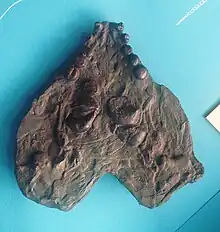
Although the shell would most likely have been too cumbersome for highly adept swimming, Cyamodus would still have been more agile than other single shelled placodonts like Henodus.[12] The shells were also covered in hexagonal plates that not only increased the level of protection but also increased their weight, a typical placodont adaptation as additional weight just beyond the level of neutral buoyancy allowed them to dive to reach shellfish. Other adaptations for protection besides the heavily armored shell include the strongly built rear of the skull and limbs that do not protrude too far. Although the reduction in limb length restricted its ability to swim, its heavy shell greatly assisted its ability to dive. Cyamodus is also expected to have had difficulty maneuvering on land and probably only ventured out of the water for periods of rest. Discovery of two fossil Cyamodus juveniles inside the stomach area of a Lariosaurus fossil has led to speculation about its vulnerability to predation.[13][14]
It has also been noted that juvenile specimens of Cyamodus have an extra tooth on the roof of their mouth, compared to adult specimens. This suggests that Cyamodus reduced the number of teeth as they grew to maturity. However, this could be due to a difference between species of Cyamodus.[4]
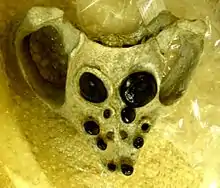
C. hildegardis from the Besano Formation (Middle Triassic) of the Alpine area of Switzerland and northern Italy has been reconstructed with a broad, laterally expanded main armor (carapace) and a separate smaller pelvic shield, giving it a sprawling appearance.[11] A reexamination of the postcranial dermal armor and endoskeletal elements of the three best preserved articulated specimens of the species has led to new interpretations of the dermal armor and underlying postcranial bones, as well as a new life reconstruction.[6][11]

Placodonts are typically considered to be durophagous (adapted to crushing hard-shelled organisms).[15] C.G. Diedrich has suggested that Cyamodus and other placodonts were algae-grazers.[6] However, this interpretation has been criticized by Torsten M. Scheyer and other researchers,[15] and many subsequent studies about placodonts have rejected Deidrich's interpretation, and the consensus that placodonts with the exception of Henodus were durophagous still continues to be strongly supported.[16][17][18][19][20][21]
References
- Wei Wang; Chun Li; Torsten M. Scheyer; Lijun Zhao (2019). "A new species of Cyamodus (Placodontia, Sauropterygia) from the early Late Triassic of south-west China". Journal of Systematic Palaeontology. 17 (17): 1237–1256. doi:10.1080/14772019.2018.1535455. S2CID 91579582.
- Dixon, Dougal (2006). The Complete Book of Dinosaurs. Hermes House.
- Strauss, Bob. "Cyamodus". About.
- Naish, Darren. "Placodonts: The Bizarre 'Walrus-Turtles' of the Triassic". Indiana University.
- Callaway, Jack; et al. (1997). Ancient Marine Reptiles. Academic Press. pp. 138–140. ISBN 978-0080527215.
- Diedrich, Cajus G. (2011). "The shallow marine placodont Cyamodus of the central European Germanic Basin: its evolution, paleobiogeography and paleoecology". Historical Biology: An International Journal of Paleobiology. 24.3 (4): 1–19. doi:10.1080/08912963.2011.575938. S2CID 128569569.
- Furrer, H. (2004). "Der Monte San Giorgio im Südtessin – vom Berg der Saurier zur Fossil-Lagerstätte internationaler Bedeutung" (PDF). Neujahrsblatt herausgegeben von der Naturforschenden Gesellschaft in Zürich: 18. S2CID 127398058.
- Paul, Gregory S. (2022). The Princeton Field Guide to Mesozoic Sea Reptiles. Princeton University Press. pp. 77–79. doi:10.1515/9780691241456. ISBN 9780691193809. S2CID 251553177.
- Diedrich, C.G. (2012). "The Middle Triassic marine reptile biodiversity in the Germanic Basin,in the centre of the Pangaean world". Central European Journal of Geosciences. 4 (1): 9–46. doi:10.2478/s13533-011-0060-0. S2CID 129930258.
- Jiang, Da-Yong; et al. (2008). "First Record of Placodontoidea (Reptilia, Sauropterygia, Placodontia) from the Eastern Tethys" (PDF). Journal of Vertebrate Paleontology. 28 (3): 904–908. doi:10.1671/0272-4634(2008)28[904:froprs]2.0.co;2. S2CID 9784064. Archived from the original (PDF) on 2015-04-02.
- Owen, R. (1858). "Description of the skull and teeth of the Placodus laticeps, Owen, with indications of other new species of Placodus, and evidence of the saurian nature of that genus". Philosophical Transactions of the Royal Society of London. 148: 169–184. doi:10.1098/rstl.1858.0009. S2CID 111331431.
- Westphal, F. (1976). "The dermal armour of some Triassic placodont reptiles". Linnean Society Symposium Series Academic Press, London. 3: 34–41.
- Rieppel, O.; et al. (1999). A skull of Cyamodus kuhnschnyderi Nosotti & Pinna 1993, from the Muschelkalk of Wassonne. France: Paläontologische Zeitschrift. pp. 377–383.
- Renesto, S.; et al. (1995). "Functional Morphology and Mode of Life of the Late Triassic placodont Psephoderma alpinum Meyer from the Calcare di Zorino (Lombardy, N Italy)". Rivista Italiana di Paleontologia e Stratigrafia. 101 (1): 37–48.
- Scheyer, Torsten M.; Neenan, James M.; Renesto, Silvio; Saller, Franco; Hagdorn, Hans; Furrer, Heinz; Rieppel, Olivier; Tintori, Andrea (2012-06-01). "Revised paleoecology of placodonts – with a comment on 'The shallow marine placodont Cyamodus of the central European Germanic Basin: its evolution, paleobiogeography and paleoecology' by C.G. Diedrich (Historical Biology, iFirst article, 2011, 1–19, doi: 10.1080/08912963.2011.575938)". Historical Biology. 24 (3): 257–267. doi:10.1080/08912963.2011.621083. ISSN 0891-2963. S2CID 83707481.
- Crofts, Stephanie B.; Neenan, James M.; Scheyer, Torsten M.; Summers, Adam P. (2017). "Tooth occlusal morphology in the durophagous marine reptiles, Placodontia (Reptilia: Sauropterygia)". Paleobiology. 43 (1): 114–128. doi:10.1017/pab.2016.27. ISSN 0094-8373. S2CID 88556195.
- Klein, Nicole; Houssaye, Alexandra; Neenan, James M.; Scheyer, Torsten M. (2015-02-23). "Long bone histology and microanatomy of Placodontia (Diapsida: Sauropterygia)". Contributions to Zoology. 84 (1): 59–S15. doi:10.1163/18759866-08401005. ISSN 1875-9866.
- Neenan, James M; Li, Chun; Rieppel, Olivier; Bernardini, Federico; Tuniz, Claudio; Muscio, Giuseppe; Scheyer, Torsten M (2014). "Unique method of tooth replacement in durophagous placodont marine reptiles, with new data on the dentition of Chinese taxa". Journal of Anatomy. 224 (5): 603–613. doi:10.1111/joa.12162. ISSN 0021-8782. PMC 3981503. PMID 24517163.
- Neenan, James M.; Klein, Nicole; Scheyer, Torsten M. (2013-03-27). "European origin of placodont marine reptiles and the evolution of crushing dentition in Placodontia". Nature Communications. 4 (1): 1621. Bibcode:2013NatCo...4.1621N. doi:10.1038/ncomms2633. ISSN 2041-1723. PMID 23535642. S2CID 21274778.
- Klein, Nicole; Scheyer, Torsten M. (2014). "A new placodont sauropterygian from the Middle Triassic of the Netherlands". Acta Palaeontologica Polonica. 59 (4): 887–902. doi:10.4202/app.2012.0147.
- Pommery, Yannick; Scheyer, Torsten M.; Neenan, James M.; Reich, Tobias; Fernandez, Vincent; Voeten, Dennis F. A. E.; Losko, Adrian S.; Werneburg, Ingmar (2021-07-05). "Dentition and feeding in Placodontia: tooth replacement in Henodus chelyops". BMC Ecology and Evolution. 21 (1): 136. doi:10.1186/s12862-021-01835-4. ISSN 2730-7182. PMC 8256584. PMID 34225664.
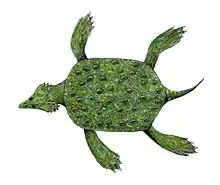
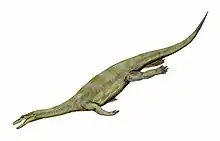


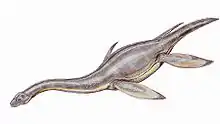
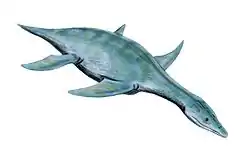
.png.webp)